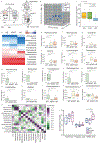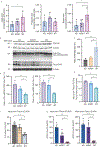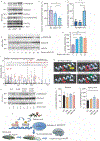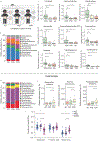Transmission of Alzheimer's disease-associated microbiota dysbiosis and its impact on cognitive function: evidence from mice and patients
- PMID: 37604976
- PMCID: PMC11733706
- DOI: 10.1038/s41380-023-02216-7
Transmission of Alzheimer's disease-associated microbiota dysbiosis and its impact on cognitive function: evidence from mice and patients
Abstract
Spouses of Alzheimer's disease (AD) patients are at a higher risk of developing incidental dementia. However, the causes and underlying mechanism of this clinical observation remain largely unknown. One possible explanation is linked to microbiota dysbiosis, a condition that has been associated with AD. However, it remains unclear whether gut microbiota dysbiosis can be transmitted from AD individuals to non-AD individuals and contribute to the development of AD pathogenesis and cognitive impairment. We, therefore, set out to perform both animal studies and clinical investigation by co-housing wild-type mice and AD transgenic mice, analyzing microbiota via 16S rRNA gene sequencing, measuring short-chain fatty acid amounts, and employing behavioral test, mass spectrometry, site-mutations and other methods. The present study revealed that co-housing between wild-type mice and AD transgenic mice or administrating feces of AD transgenic mice to wild-type mice resulted in AD-associated gut microbiota dysbiosis, Tau phosphorylation, and cognitive impairment in the wild-type mice. Gavage with Lactobacillus and Bifidobacterium restored these changes in the wild-type mice. The oral and gut microbiota of AD patient partners resembled that of AD patients but differed from healthy controls, indicating the transmission of microbiota. The underlying mechanism of these findings includes that the butyric acid-mediated acetylation of GSK3β at lysine 15 regulated its phosphorylation at serine 9, consequently impacting Tau phosphorylation. Pending confirmative studies, these results provide insight into a potential link between the transmission of AD-associated microbiota dysbiosis and development of cognitive impairment, which underscore the need for further research in this area.
© 2023. The Author(s), under exclusive licence to Springer Nature Limited.
Figures







Update of
-
Transmission of Alzheimer's Disease-Associated Microbiota Dysbiosis and its Impact on Cognitive Function: Evidence from Mouse Models and Human Patients.Res Sq [Preprint]. 2023 Apr 28:rs.3.rs-2790988. doi: 10.21203/rs.3.rs-2790988/v1. Res Sq. 2023. Update in: Mol Psychiatry. 2023 Oct;28(10):4421-4437. doi: 10.1038/s41380-023-02216-7. PMID: 37162940 Free PMC article. Updated. Preprint.
Comment in
-
Could microbiota transfer between cohabitants influence Alzheimer disease risk?Nat Rev Neurol. 2023 Dec;19(12):713-714. doi: 10.1038/s41582-023-00894-z. Epub 2023 Oct 20. Nat Rev Neurol. 2023. PMID: 37864078 No abstract available.
Similar articles
-
Transmission of Alzheimer's Disease-Associated Microbiota Dysbiosis and its Impact on Cognitive Function: Evidence from Mouse Models and Human Patients.Res Sq [Preprint]. 2023 Apr 28:rs.3.rs-2790988. doi: 10.21203/rs.3.rs-2790988/v1. Res Sq. 2023. Update in: Mol Psychiatry. 2023 Oct;28(10):4421-4437. doi: 10.1038/s41380-023-02216-7. PMID: 37162940 Free PMC article. Updated. Preprint.
-
Altered microbiomes distinguish Alzheimer's disease from amnestic mild cognitive impairment and health in a Chinese cohort.Brain Behav Immun. 2019 Aug;80:633-643. doi: 10.1016/j.bbi.2019.05.008. Epub 2019 May 4. Brain Behav Immun. 2019. PMID: 31063846
-
Patchouli alcohol attenuates the cognitive deficits in a transgenic mouse model of Alzheimer's disease via modulating neuropathology and gut microbiota through suppressing C/EBPβ/AEP pathway.J Neuroinflammation. 2023 Jan 30;20(1):19. doi: 10.1186/s12974-023-02704-1. J Neuroinflammation. 2023. PMID: 36717922 Free PMC article.
-
Gut Microbiota and Alzheimer's Disease: Pathophysiology and Therapeutic Perspectives.J Alzheimers Dis. 2021;83(3):963-976. doi: 10.3233/JAD-210381. J Alzheimers Dis. 2021. PMID: 34366348 Review.
-
Gut Microbiota and Immunotherapy for Alzheimer's Disease.Int J Mol Sci. 2022 Dec 3;23(23):15230. doi: 10.3390/ijms232315230. Int J Mol Sci. 2022. PMID: 36499564 Free PMC article. Review.
Cited by
-
Microbial diversity and fitness in the gut-brain axis: influences on developmental risk for Alzheimer's disease.Gut Microbes. 2025 Dec;17(1):2486518. doi: 10.1080/19490976.2025.2486518. Epub 2025 Apr 10. Gut Microbes. 2025. PMID: 40207973 Free PMC article. Review.
-
Comparison of Frailty and Chronological Age as Determinants of the Murine Gut Microbiota in an Alzheimer's Disease Mouse Model.Microorganisms. 2023 Nov 24;11(12):2856. doi: 10.3390/microorganisms11122856. Microorganisms. 2023. PMID: 38138000 Free PMC article.
-
Advances in the prevention and treatment of Alzheimer's disease based on oral bacteria.Front Psychiatry. 2023 Dec 13;14:1291455. doi: 10.3389/fpsyt.2023.1291455. eCollection 2023. Front Psychiatry. 2023. PMID: 38156323 Free PMC article. Review.
-
Modulation of Alzheimer's disease brain pathology in mice by gut bacterial depletion: the role of IL-17a.Gut Microbes. 2024 Jan-Dec;16(1):2363014. doi: 10.1080/19490976.2024.2363014. Epub 2024 Jun 21. Gut Microbes. 2024. PMID: 38904096 Free PMC article.
-
Emerging role of the host microbiome in neuropsychiatric disorders: overview and future directions.Mol Psychiatry. 2023 Sep;28(9):3625-3637. doi: 10.1038/s41380-023-02287-6. Epub 2023 Oct 16. Mol Psychiatry. 2023. PMID: 37845499 Free PMC article. Review.
References
MeSH terms
Substances
Grants and funding
LinkOut - more resources
Full Text Sources
Medical
Molecular Biology Databases

